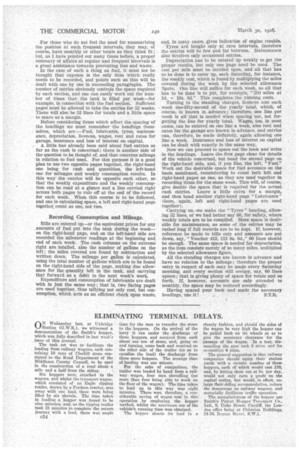ELIMINATING TERMINAL DELAYS.
Page 32

If you've noticed an error in this article please click here to report it so we can fix it.
ON Wednesday last, at Uxbridge Station (G.W.R.), we witnessed a demonstration of the Smith's hopper, which was hilly described in last week's issue of this journal.
The task set was to facilitate the loading from railway wagons, each containing 10 tons of CIeehill stone consigned to the Road Department of the Middlesex County Council, to be used in the construction of a road about a mile and a half from the siding.
Six hoppers were, attached to •the wagons, and whilst the transport wagon, which consisted of an Eagle tipping trailer, drawn by a Fordson tractor, was away with one load, these were being filled by six shovels. The time taken in loading a hopper was found to be nine minutes, and, as the tipping trailer took 21 minutes to complete the return journey. with a load, there was ample
e34
time for the men to transfer the stone to the hoppers. On the arrival of the lorry it ran under the discharge of three hoppers, and received from each about one ton of stone, and, going on and turning, came back and received on the other side of the trailer (so as to equalize the load) the discharge from three more hoppers. The average time of loading was one minute.
For the sake of comparison, the trailer was loaded by hand from a railway wagon, four men shovelling (no more than four being able to work on the floor of the wagon). The time taken to load up in this way was eight minutes. There was, therefore, a considerable saving of wages cost in this operation by employing the hopper method, whilst the maximum use of the vehicle's running time was obtained.
The hopper shoots its load in a
cleanly fashion, and should the sides of the wagon be very high the hopper can he pulled back on its wheels so as to give the necessary clearance for the passage of the wagon. In a test, dismantling the gear took 3 mins, and its re-erection 4 mins.
The general suggestion is that railway companies should equip their station yards with a certain number of these hoppers, each of which woilld cost £10, and, by letting them out at Sc. Per day, would not only earn a profit on the capital outlay, but would, in effect, enlarge their siding accommodation, reduce the demurrage on railway wagons, and materially facilitate traffic operation.
The manufacturers of the hopper are Smith's Patent Hopper Transport Co., Ltd., 9, Duke Street, Cardiff, the London office being at Criterion Buildings, 24-36. Regent Street, S.W.1. '


































